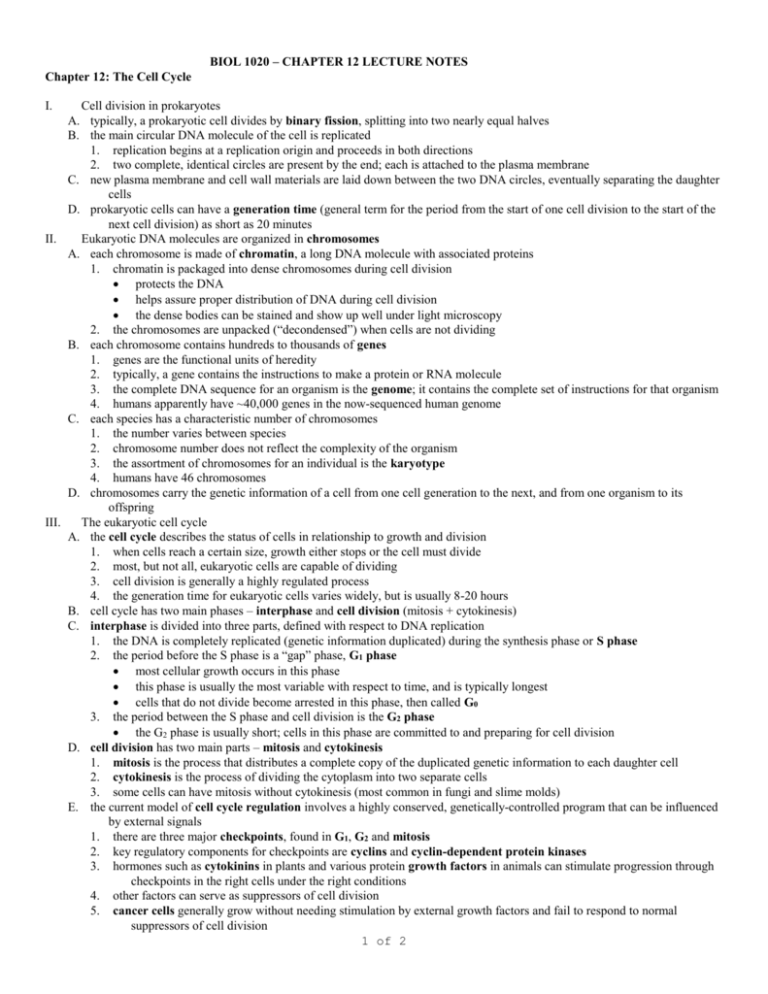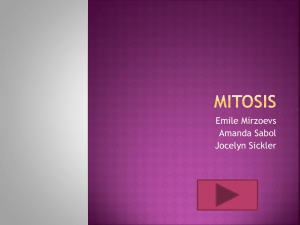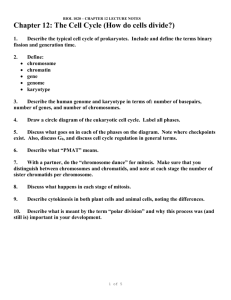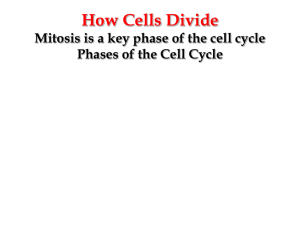Chapter 12: The Cell Cycle
advertisement

BIOL 1020 – CHAPTER 12 LECTURE NOTES Chapter 12: The Cell Cycle I. Cell division in prokaryotes A. typically, a prokaryotic cell divides by binary fission, splitting into two nearly equal halves B. the main circular DNA molecule of the cell is replicated 1. replication begins at a replication origin and proceeds in both directions 2. two complete, identical circles are present by the end; each is attached to the plasma membrane C. new plasma membrane and cell wall materials are laid down between the two DNA circles, eventually separating the daughter cells D. prokaryotic cells can have a generation time (general term for the period from the start of one cell division to the start of the next cell division) as short as 20 minutes II. Eukaryotic DNA molecules are organized in chromosomes A. each chromosome is made of chromatin, a long DNA molecule with associated proteins 1. chromatin is packaged into dense chromosomes during cell division protects the DNA helps assure proper distribution of DNA during cell division the dense bodies can be stained and show up well under light microscopy 2. the chromosomes are unpacked (“decondensed”) when cells are not dividing B. each chromosome contains hundreds to thousands of genes 1. genes are the functional units of heredity 2. typically, a gene contains the instructions to make a protein or RNA molecule 3. the complete DNA sequence for an organism is the genome; it contains the complete set of instructions for that organism 4. humans apparently have ~40,000 genes in the now-sequenced human genome C. each species has a characteristic number of chromosomes 1. the number varies between species 2. chromosome number does not reflect the complexity of the organism 3. the assortment of chromosomes for an individual is the karyotype 4. humans have 46 chromosomes D. chromosomes carry the genetic information of a cell from one cell generation to the next, and from one organism to its offspring III. The eukaryotic cell cycle A. the cell cycle describes the status of cells in relationship to growth and division 1. when cells reach a certain size, growth either stops or the cell must divide 2. most, but not all, eukaryotic cells are capable of dividing 3. cell division is generally a highly regulated process 4. the generation time for eukaryotic cells varies widely, but is usually 8-20 hours B. cell cycle has two main phases – interphase and cell division (mitosis + cytokinesis) C. interphase is divided into three parts, defined with respect to DNA replication 1. the DNA is completely replicated (genetic information duplicated) during the synthesis phase or S phase 2. the period before the S phase is a “gap” phase, G1 phase most cellular growth occurs in this phase this phase is usually the most variable with respect to time, and is typically longest cells that do not divide become arrested in this phase, then called G0 3. the period between the S phase and cell division is the G2 phase the G2 phase is usually short; cells in this phase are committed to and preparing for cell division D. cell division has two main parts – mitosis and cytokinesis 1. mitosis is the process that distributes a complete copy of the duplicated genetic information to each daughter cell 2. cytokinesis is the process of dividing the cytoplasm into two separate cells 3. some cells can have mitosis without cytokinesis (most common in fungi and slime molds) E. the current model of cell cycle regulation involves a highly conserved, genetically-controlled program that can be influenced by external signals 1. there are three major checkpoints, found in G1, G2 and mitosis 2. key regulatory components for checkpoints are cyclins and cyclin-dependent protein kinases 3. hormones such as cytokinins in plants and various protein growth factors in animals can stimulate progression through checkpoints in the right cells under the right conditions 4. other factors can serve as suppressors of cell division 5. cancer cells generally grow without needing stimulation by external growth factors and fail to respond to normal suppressors of cell division 1 of 2 BIOL 1020 – CHAPTER 12 LECTURE NOTES mitosis is generally be divided into 4 stages: prophase, metaphase, anaphase, and telophase (PMAT) A. be aware that mitosis is a continuous process, the stages are defined only for our convenience B. prophase – chromatin condenses to form chromosomes 1. each chromosome (duplicated during S phase) forms a pair of sister chromatids sister chromatids are joined at a centromere by protein tethers centromeres contain a kinetochore where microtubules will bind each sister chromatid has its own kinetochore 2. a system of microtubules, called the mitotic spindle, organizes between the two poles (opposite ends) of the cell each pole has a microtubule organizing center (MTOC) in animals and some other eukaryotes, centrioles are found in the MTOC; their exact role, if any, is unclear 3. by the end of prophase: the nuclear membrane has disappeared (actually divided into many small vesicles) nucleoli have disintegrated the sister chromatids are attached by their kinetochores to microtubules from opposite poles 4. some call the later part of prophase prometaphase, usually defined to include vesicularization of the nuclear membrane and attachment of kinetochores to microtubules 5. in some eukaryotes the nuclear membrane never vesicularizes C. metaphase – chromosomes line up along the midplane of the cell (the metaphase plate) 1. chromosomes are most condensed, most visible, and most distinguishable during metaphase 2. the mitotic spindle, now complete, has two types of microtubules kinetochore microtubules extend from a pole to a kinetochore polar microtubules extend from a pole to the midplane area, often overlapping with polar microtubules from the other pole 3. the mitosis checkpoint appears to be here; progress past metaphase is typically prevented until the kinetochores are all attached to microtubules D. anaphase – sister chromatids separate and are moved toward opposite poles 1. the protein tethers at the centromere between the chromatids are broken 2. each former sister chromatid can now be called a chromosome 3. model for the mechanism that moves chromosomes to the poles motor proteins move the chromosomes towards the poles along the kinetochores microtubules kinetochore microtubules shorten as behind the moving chromosomes polar microtubules lengthen the entire spindle motor proteins on the polar microtubules slide them past each other, pushing them apart (the microtubules may grow a bit, too) this pushes the MTOCs away from each other, and thus has the effect of pushing kinetochore microtubules from opposite poles away from each other 4. overall, this process assures that each daughter cell will receive one of the duplicate sets of genetic material carried by the chromosomes E. telophase – the processes of prophase are reversed 1. the mitotic spindle is disintegrated 2. the chromosomes decondense 3. nuclear membranes reform around the genetic material to form two nuclei, each with an identical copy of the genetic information 4. nucleoli reappear, and interphase cellular functions resume V. cytokinesis divides the cell into two daughter cells A. cytokinesis usually begins in telophase and ends shortly thereafter 1. in animals, a cleavage furrow develops – usually close to where the metaphase plate was a microfilament (actin) ring contracts due to interactions with myosin molecules, forming a deepening furrow eventually, the ring closes enough for spontaneous separation of the plasma membrane, resulting in two separate cells 2. in plants, a cell plate develops – usually close to where the metaphase plate was vesicles that originate from the Golgi line up in the equatorial region the vesicles fuse and add more vesicles, growing outward until reaching the plasma membrane and thus separating the cells the vesicles contain materials for making the primary cell wall and a middle lamella B. cytoplasm (and with it most organelles) is usually distributed randomly but roughly equally between daughter cells C. sometimes cell division is a highly regulated polar division that purposefully distributes some materials unequally IV. 2 of 2








